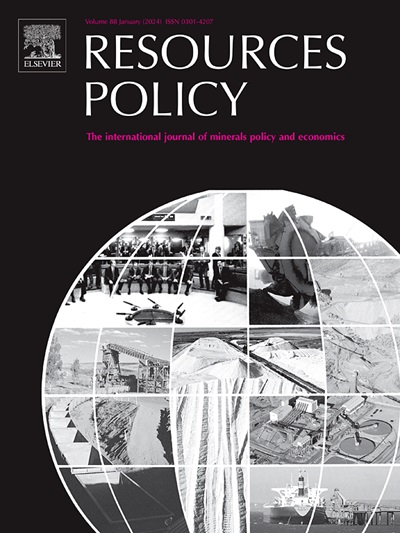Analyzing the interplay between money supply, mineral extraction, industrialization, and ecological footprint in latin America's global south: A symmetrical perspective
IF 10.2
2区 经济学
0 ENVIRONMENTAL STUDIES
引用次数: 0
Abstract
The primary goal of this study is to examine the long-term impact of money supply, natural resource use, mineral extraction, industrialization, green energy use, and population density on the ecological footprint (EFP) in 11 high natural resource–based Latin American Global South nations from 1990 to 2021. The study employs Westerlund bootstrap LM, pooled mean group autoregressive distributed lag (PMG-ARDL), and Dumitrescu and Hurlin causality tests. Initially, Westerlund Bootstrap LM statistics reveal significant evidence of cointegration among the variables. Second, the PMG model results show that all regressors except green energy use have a significant positive effect on EFP in the long run, whereas, in the short run, all variables are found to have insignificant impact, excluding green energy use and industrialization. Finally, Dumitrescu and Hurlin tests indicate unidirectional causality of all the regressors with EFP, except mineral extraction and population density. The findings reveal some valuable policy implications for reducing EFP. Initially, central banks must initially limit money supply while altering the interest rate minimally. Over time, central banks must also promote green lending practices in industrial production sectors and charge higher interest on loans to firms that use outdated technology in industrial production. Furthermore, firms engaged in mineral and natural resource extraction must replace old equipment with new technologies that use green energy to curtail pollution emissions.
求助全文
约1分钟内获得全文
求助全文
来源期刊

Resources Policy
ENVIRONMENTAL STUDIES-
CiteScore
13.40
自引率
23.50%
发文量
602
审稿时长
69 days
期刊介绍:
Resources Policy is an international journal focused on the economics and policy aspects of mineral and fossil fuel extraction, production, and utilization. It targets individuals in academia, government, and industry. The journal seeks original research submissions analyzing public policy, economics, social science, geography, and finance in the fields of mining, non-fuel minerals, energy minerals, fossil fuels, and metals. Mineral economics topics covered include mineral market analysis, price analysis, project evaluation, mining and sustainable development, mineral resource rents, resource curse, mineral wealth and corruption, mineral taxation and regulation, strategic minerals and their supply, and the impact of mineral development on local communities and indigenous populations. The journal specifically excludes papers with agriculture, forestry, or fisheries as their primary focus.
 求助内容:
求助内容: 应助结果提醒方式:
应助结果提醒方式:


